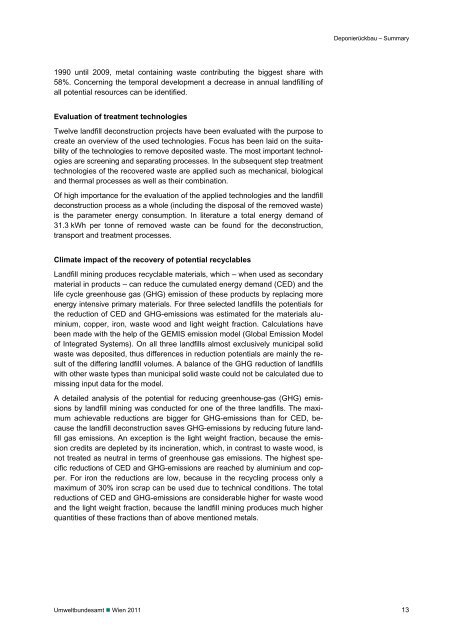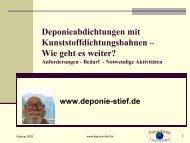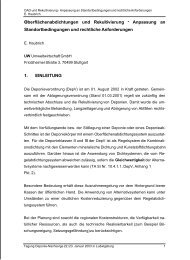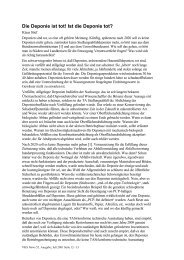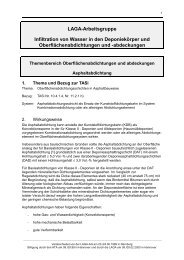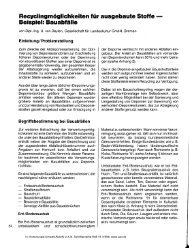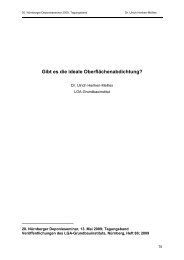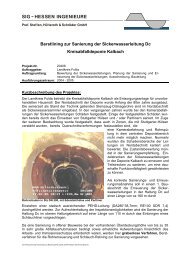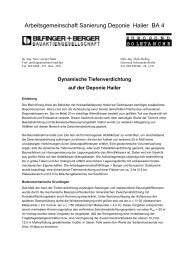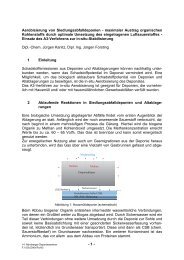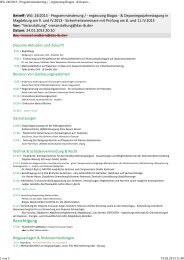verfügbar hier
verfügbar hier
verfügbar hier
Erfolgreiche ePaper selbst erstellen
Machen Sie aus Ihren PDF Publikationen ein blätterbares Flipbook mit unserer einzigartigen Google optimierten e-Paper Software.
1990 until 2009, metal containing waste contributing the biggest share with<br />
58%. Concerning the temporal development a decrease in annual landfilling of<br />
all potential resources can be identified.<br />
Evaluation of treatment technologies<br />
Twelve landfill deconstruction projects have been evaluated with the purpose to<br />
create an overview of the used technologies. Focus has been laid on the suitability<br />
of the technologies to remove deposited waste. The most important technologies<br />
are screening and separating processes. In the subsequent step treatment<br />
technologies of the recovered waste are applied such as mechanical, biological<br />
and thermal processes as well as their combination.<br />
Of high importance for the evaluation of the applied technologies and the landfill<br />
deconstruction process as a whole (including the disposal of the removed waste)<br />
is the parameter energy consumption. In literature a total energy demand of<br />
31.3 kWh per tonne of removed waste can be found for the deconstruction,<br />
transport and treatment processes.<br />
Climate impact of the recovery of potential recyclables<br />
Landfill mining produces recyclable materials, which – when used as secondary<br />
material in products – can reduce the cumulated energy demand (CED) and the<br />
life cycle greenhouse gas (GHG) emission of these products by replacing more<br />
energy intensive primary materials. For three selected landfills the potentials for<br />
the reduction of CED and GHG-emissions was estimated for the materials aluminium,<br />
copper, iron, waste wood and light weight fraction. Calculations have<br />
been made with the help of the GEMIS emission model (Global Emission Model<br />
of Integrated Systems). On all three landfills almost exclusively municipal solid<br />
waste was deposited, thus differences in reduction potentials are mainly the result<br />
of the differing landfill volumes. A balance of the GHG reduction of landfills<br />
with other waste types than municipal solid waste could not be calculated due to<br />
missing input data for the model.<br />
A detailed analysis of the potential for reducing greenhouse-gas (GHG) emissions<br />
by landfill mining was conducted for one of the three landfills. The maximum<br />
achievable reductions are bigger for GHG-emissions than for CED, because<br />
the landfill deconstruction saves GHG-emissions by reducing future landfill<br />
gas emissions. An exception is the light weight fraction, because the emission<br />
credits are depleted by its incineration, which, in contrast to waste wood, is<br />
not treated as neutral in terms of greenhouse gas emissions. The highest specific<br />
reductions of CED and GHG-emissions are reached by aluminium and copper.<br />
For iron the reductions are low, because in the recycling process only a<br />
maximum of 30% iron scrap can be used due to technical conditions. The total<br />
reductions of CED and GHG-emissions are considerable higher for waste wood<br />
and the light weight fraction, because the landfill mining produces much higher<br />
quantities of these fractions than of above mentioned metals.<br />
Deponierückbau – Summary<br />
Umweltbundesamt Wien 2011 13


